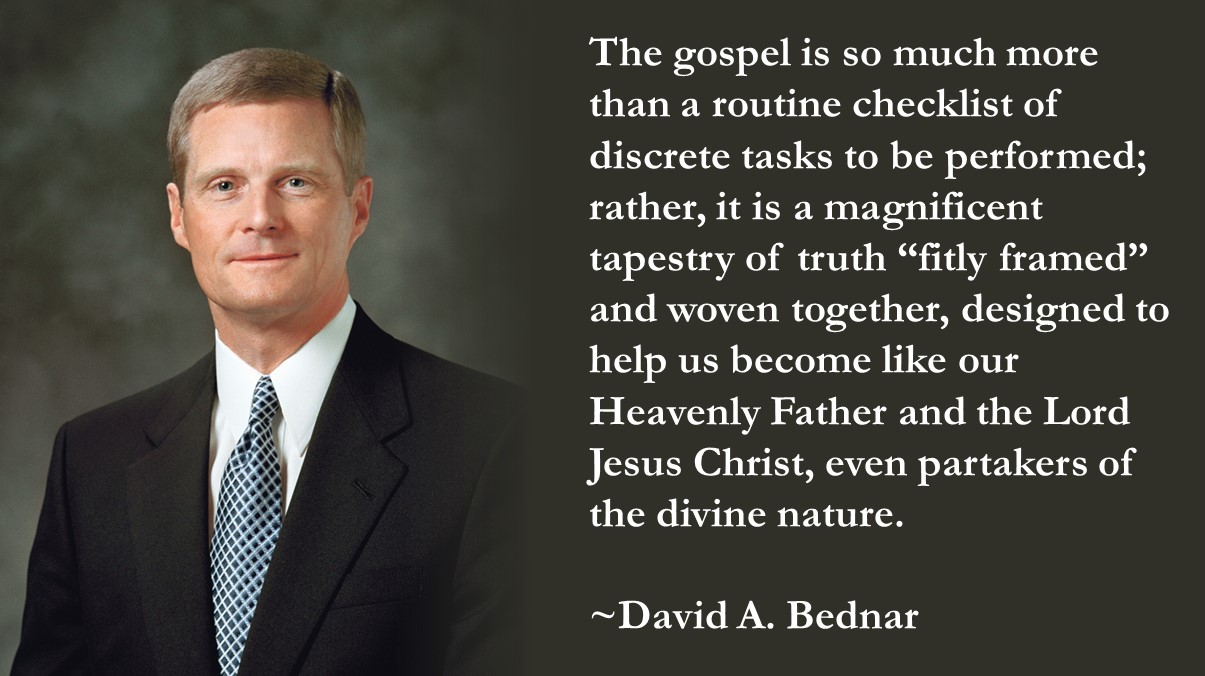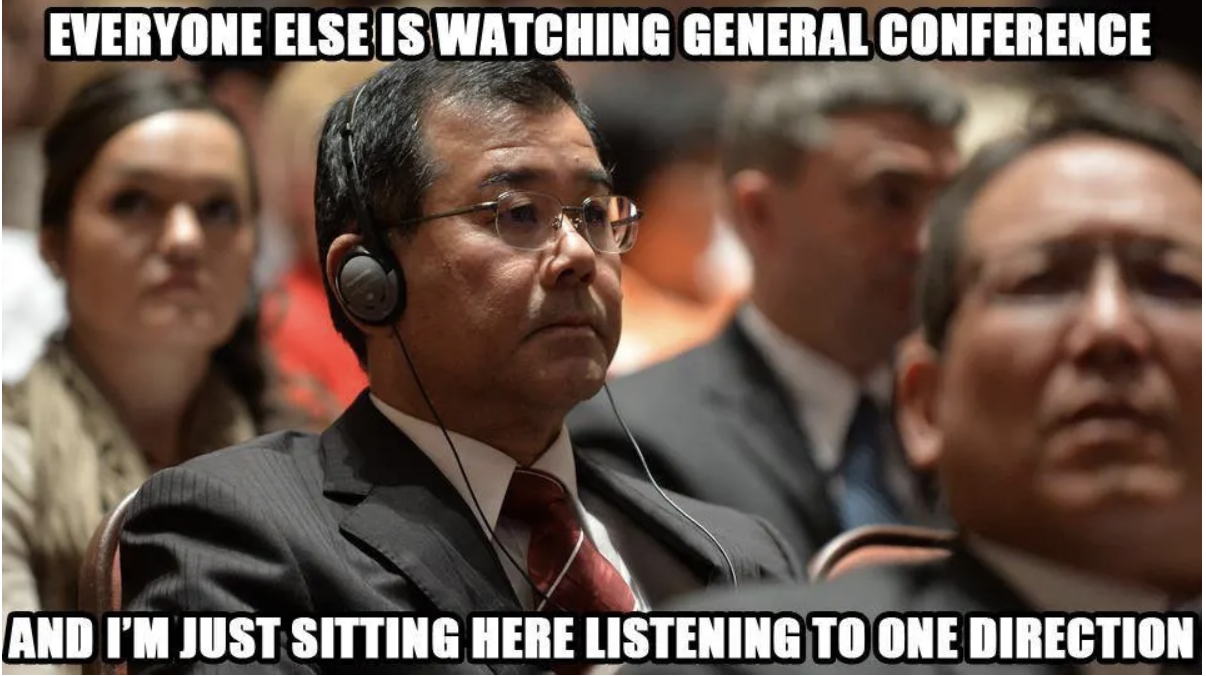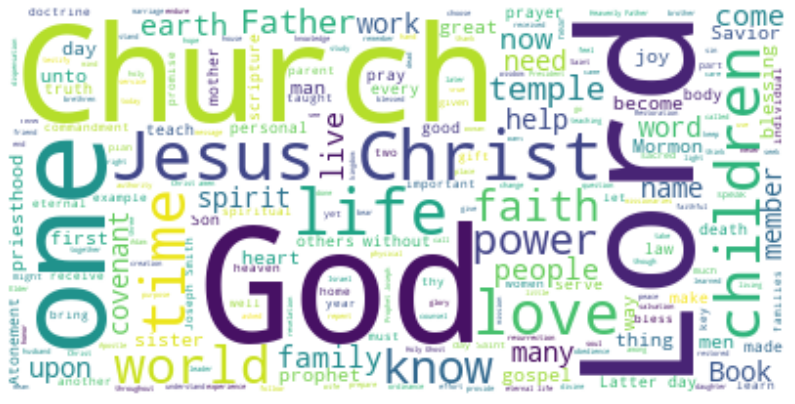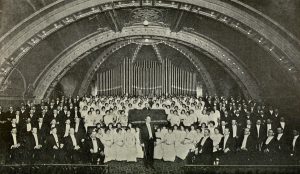Category: General Conference
-

Thoughts on David A. Bednar
I recently worked on reviewing the addresses of Elder David A. Bednar to put together a David A. Bednar quotes page over at From the Desk. As I worked on it, I noticed some interesting patterns and other observations that I thought I would share. These include a standardized structure he seems to follow, some…
-

General Conference as a “Peaceable Thing of the Kingdom”
The Listener, by James Christensen I’ve been as guilty as anyone of, subconsciously and in the back of my mind, looking forward to General Conference more for the big announcements or controversy than the spiritual nourishment. Reading about the controversy and ensuing outrage (and counter-outrage) in particular are kind of an emotional crack cocaine for…
-

General Conference and Our Shrinking Attention Spans
As the father of a lot of small, messy children, I easily listen to two hours of podcasts a day while cleaning (how my parents’ generation cleaned before podcasts I have no idea). The other day a movie producer on a podcast made a comment about how, in the days before streaming, television producers would…
-
Mother in Heaven: The Quotes Behind the Essay
On the Saturday evening session of General conference, Elder Renlund stated that: “Very little has been revealed about mother in heaven but what we do know is summarized in a Gospel Topic found in our Gospel Library application. Once you have read what is there, you will know everything that I know about the subject.”…
-
Studying the Words of The Relief Society Presidency
If the 5-year cycle for Relief Society General Presidencies that has been followed for 20 years holds true, the current Relief Society Presidency is likely to be released at this upcoming general conference. With that in mind, I recently decided to go through and read all of the general conference talks given by members of…
-
Hearing leaders teach in their own languages: October 2021 General Conference edition
Do you remember that time when speakers in General Conference were allowed to speak in their own languages? In September of 2014, the Church put out an announcement that “General Conference Speakers Now Can Use Native Language”! But it didn’t last long. A year later, a Church spokesperson told a news outlet that the First…
-
The Most Significant General Conference Addresses of the 2010s: A Tentative List
With the 2010s a year behind us now, I thought it might be a good time to look back at general conference in the 2010s and consider which of the talks were some of the most significant addresses given during that period. I suspect that the Gospel Topics Essays will be the most significant documents…
-

President Nelson’s Sources
What is it about our Church leaders that lends their speeches authority? While ultimately the belief that the men we sustain as prophets, seers, and revelators are in communication with God is what lends them the greatest amount of authority, I believe that there are other factors that shape how they are perceived and how…
-
President Nelson’s Favorite Topics and Statements, Part 4: The Plan of Salvation
For forty years before his call to the Quorum of the Twelve, Russel M. Nelson spent his career as a cardiovascular and thoracic surgeon. One aspect of his work that had a profound impact on him was that it “brought me into contact almost daily with seriously ill patients who faced the real prospect of…
-
President Nelson’s Favorite Topics and Statements, Part 3: The Family
Throughout my time studying President Nelson’s conference addresses, I observed that one topic that he came back to over and over is families. Whether it be decrying the fragmentation of families, encouraging men to pay more attention to their wives, or offering encouragement to women who are mothers, Russell M. Nelson has had a lot…
-
President Nelson’s Favorite Topics and Statements, Part 2: The Church
Last year, the Church released the guidelines by which a committee was evaluating hymns and songs for inclusion in the next hymnbook and children’s songbook and a list of topics they wanted to see more hymns about. What surprised me as I studied President Russell M. Nelson’s general conference talks was how frequently the list…
-

President Nelson’s Favorite Topics and Statements, Part 1: God and Power
This is the beginning of the second part of my analysis of President Russell M. Nelson’s general conference talks, focusing on his favorite topics and statements. In looking at what President Nelson talks about, I tried to take a few approaches to understand his favorite topics objectively. Approaches included word count analysis of his talks…
-
President Nelson’s Conference Addresses, Part 1: Introductory Comments
A couple years back—not long after President Russell M. Nelson was sustained as President of the Church of Jesus Christ of Latter-day Saints—Elder Neil L. Anderson spoke of a project his wife undertook: While my wife, Kathy, has known President Nelson personally for nearly three decades and has no question about his divine mantle, upon…
-
Quotes to accompany your Come Follow Me study – Alma 30-31
This coming week’s Come, Follow Me lesson covers Alma 30-31. Here are a collection of quotes from General Auxiliary Leaders of the Church, that you can use in your family or personal study. Alma 30 The Book of Mormon warns against false teachings. “As you use your agency to carve out time every day to…
-

A Tale of Two Statues
There are several statues that exist at Temple Square in Salt Lake City, but two stand out as the most well-known and prominent. The first is the Angel Moroni, standing at the highest spire of the Salt Lake Temple. Created by Cyrus E. Dallin, the statue of the angel represents the Book of Mormon prophet…
-

COVID, Conference, and Choir
The world is facing extraordinary times. With the COVID-19 pandemic raging worldwide, everyone is (or soon will be) feeling an impact from it in one way or another. It will likely leave some lasting changes on our society. Within the Church, it provides us with an extraordinary opportunity to reflect on how we have been…
-

The Church of the Devil and the Church of the Lamb of God
One of the more controversial aspects of Nephi’s vision of the tree of life is the great and abominable church or church of the devil. In his record, Nephi states that “there are save two churches only; the one is the church of the Lamb of God, and the other is the church of the…
-
A Tool to Make It Easier to Draw on the Wisdom of Women
In General Conference in 2015, President Russell M. Nelson stated, “We need women who have a bedrock understanding of the doctrine of Christ and who will use that understanding to teach and help raise a sin-resistant generation.” The following year, President Neill F. Marriott of the Young Women General Presidency taught, “The Lord’s Church needs…
-
First Vision Resources
We were left with a bit of a cliff hanger at the end of general conference this year—the promise of a unique general conference next April celebrating the 200th anniversary of the year Joseph Smith said he experienced the First Vision. President Russell M. Nelson spoke briefly of various events in Church history, including the…
-
Worst General Conference posts, ranked
General Conference begins in two days. I’m looking forward to it, but not as much to the online responses.
-
Grace and Cooperative Salvation
Since at least the time of Augustine of Hippo and Pelagius, western Christianity has been embroiled in a debate about salvation and grace. The two extremes have been represented as salvation by grace alone and earning salvation by our own works. Theologians and Church leaders in the Church of Jesus Christ of Latter-day Saints have…
-

Which are the most influential General Conference talks?
After most General Conferences, there are one or two talks that really stay with me. Some of those talks enter the language of many members, such as Elder Oaks’s framing of choices that are “good, better, best.” Is there any way to identify the most influential talks? We could begin with who influences the influencers.…
-
Soccer and Sunday
General Conference seems to come and go so quickly now. This must have something to do with the ease of streaming it live into every home — 10 hours of Conference in one weekend is more than enough for most of us. Once upon a time getting the Conference Ensign was a treat. Not so…
-
Loosening the iron grip of the King James Version of the Bible?
A couple of years ago, Elder Richard Maynes (of the Presidency of the Seventy) quoted Matthew 13:44 in his conference talk: “The kingdom of heaven is like treasure hidden in a field, which a man found and covered up; then in his joy he goes and sells all that he has and buys that field.” But wait…
-
Conditional Love Is Back
The recently announced LDS doctrine of conditional divine love comes from President Nelson’s 2003 Ensign article “Divine Love,” in which he stated: “While divine love can be called perfect, infinite, enduring, and universal, it cannot correctly be characterized as unconditional.” No additional commentary was added until the October 2016 General Conference, when two apostles, citing…
-
Conference Theme: No Trouble Here, Move Along
After a turbulent six months, many were expecting some bold declarations at this weekend’s General Conference. That did not come to pass. Just a few weeks ago, Elder Ballard directed CES teachers to stop teaching folklore, stop evading tough questions from students, and start reading publications by faithful LDS scholars. In his Saturday afternoon Conference…
-

Entitled
I very much enjoyed Elder Renlund’s comments on entitlement. First, because he made clear one of the reasons why we should be very conscientious about how we give help. It affects the receiver’s spiritual progression. Second, the King Benjamin-esque tie-in to all of us who, like any Church welfare recipient, are beggars before God. Lastly,…
-

The General Conference Mirth Index – Take 2
I always enjoy the opportunity to laugh a little bit in general conference. In January, I introduced the General Conference Mirth Index (for the October 2014 conference), which sums up the number of laughs for each talk. As we enter into the next General Conference this weekend, let’s see how much laughing we did last…
-
GenConf: Sunday Afternoon Session
Choir: He Is Risen President Uchtdorf conducted this opening session. Choir: My Redeemer Lives Invocation: S. Gilford Nielsen Choir: He Sent His Son Elder Robert D. Hales: Preserving Agency, Protecting Religious Freedom The blessings we enjoy now are because we made the choice to follow the Savior before this life. To everyone hearing or reading these…

